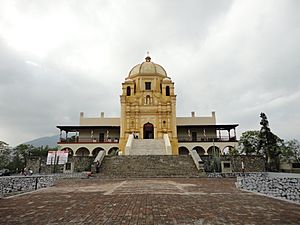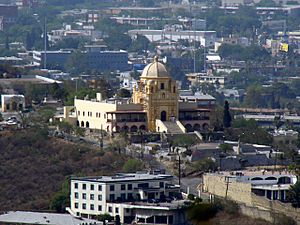Palacio del Obispado facts for kids
| Museo Regional de Nuevo León | |
 |
|
| Lua error in Module:Location_map at line 420: attempt to index field 'wikibase' (a nil value). | |
| Former name | Palacio del Obispado |
|---|---|
| Established | September 20, 1956 |
| Location | Monterrey, Nuevo Leon, MX |
| Type | History Museum |
The Palacio del Obispado, which means Bishop's Palace in Spanish, is also known as El Obispado or the Bishop's Museum. Its first name was Palacio de Nuestra Señora de Guadalupe. This old building from the 1700s is in Monterrey, Nuevo León state, in northeastern Mexico. It was built between 1787 and 1788. The idea for it came from Rafael José Verger, who was the second bishop of the Linares area.
The palace sits on top of a hill called Chepa Verde. This hill got its name because it was surrounded by land owned by José Vera. The palace was built on the side of this hill, which is now called Cerro del Obispado (Bishop Hill) because of the important building on it.
This building has been used for many things. It was a military fort and a public walking area. Since September 20, 1956, it has been home to the Regional Museum of Nuevo León.
Contents
History of the Bishop's Palace
During the time of Charles III of Spain, Pope Pius VI created a new church area called the Diocese of Linares in 1777. A diocese is like a special church district led by a bishop. Even though it was named after Linares, the city of Monterrey soon became the main center for this new diocese. Today, it is known as the Archdiocese of Monterrey.
The king asked the Pope to name Antonio de Jesús Sacedón as the first bishop. He was given the job in 1779, but he passed away before he could arrive in Linares. So, the Pope chose Rafael José Verger to be the next bishop.
As soon as Bishop Verger took his new role, he asked the Pope to move the main office of the Bishop to Monterrey. He believed Monterrey was the only city important enough for it.
Building and Fixing the Palace
The Bishop's Palace was built at the end of the time when Spain ruled Mexico. Franciscan Friar Rafael José Verger wanted a special "House of Repose and Worship" built. The city of Monterrey gave him the land in 1787.
After Friar Rafael José Verger passed away and Mexico became independent, the palace was used as a military fort. It played a very important part in defending the city during several wars. These included the Mexican–American War in 1846, the Second French intervention in Mexico in 1864, the Plan de la Noria in 1871, and the Mexican Revolution in 1913 and 1914.
By the late 1800s, the Mexican government and the state of Nuevo León made an agreement. The federal government kept the palace building. However, about 30 hectares (around 74 acres) of the hill and its surrounding land went to the state.
The palace itself was damaged and changed over time. It was left empty and in ruins for many years. It was even used as a hospital during sickness outbreaks in 1893 and 1903. In 1920, it became a place for entertainment called a cabaret.
This building, now known as the Obispado, is very important for its history and its design. The first time it was fixed up was in 1946. Ten years later, in 1956, it opened as a museum. By 1998, the hallways of the main building were restored, and the inside of the dome was decorated.
Architecture and Design
The Bishop's Palace was built in the Spanish colonial Baroque style. This style is known for being very fancy and detailed. The tower has a dome and a facade (the front part of a building) made of carved stone.

It is one of the oldest buildings in Monterrey, finished by the end of the 1700s.
The palace stands out because it is very large. Its walls are also very strong and tall. The main front of the building shows off its Baroque style. Its special pillars, called stipes, make the grand dome look even more impressive. The dome was finished between 1853 and 1857.
The building is made of ashlar stone. This is a type of stone that is cut very smoothly. It was a common building material in the area. The palace is one of the few examples of buildings from the time of the Spanish rulers that are still standing in northeastern Mexico.
Gallery
See also
 In Spanish: El Obispado para niños
In Spanish: El Obispado para niños
- Roman Catholic Archdiocese of Monterrey
External links







